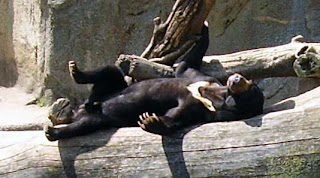Full circle
When I met Mr. thalarctos at a dinner party at the Center for Urban Horticulture lo so many years ago, we were studying at the same summer intensive language program--I was studying Khmer, and he was studying Vietnamese--so I remember making some throwaway joke about a supposed Vieto-Irish language connection (nerdy jokes that require a whole lot of specialized knowledge to be even mildly funny, if that much, my specialty: this particular pun hinged on the fact that the word for "cow" is "bó" in Irish Gaelic, and "bò" in Vietnamese). Then I proceeded to spill a glass of red wine all over the notes he was supposed to sing from with the gamelan later that night--the lyrics were in Sundanese, a language he does not know, so he needed his crib sheet for the performance. From lame humor to full adrenaline panic in less than 60 seconds.
After that inauspicious start, it's a wonder he would still speak to me, much less that we hit it off so well we've been together the 15 years since then. The Center for Urban Horticulture is no longer there in the same form, having been intentionally firebombed, burnt down, and rebuilt in the meantime. And I just learned of another unexpected British Isles-Southeast Asian linguistic parallelism--convergent evolution, rather than homology; in neither case am I positing some grand overarching language family or anything: just two interesting coincidences in how people thousands of miles away from each other arrived independently at similar constructions.
I learned the following from a commenter over at Pharyngula, Dan S.:
And amusingly, one reading of the name of that most famous wandering Geatish hero, Beowulf, has it as 'beo' (bee) + 'wulf' (wolf) - that is, bee-wolf, i.e. bear, in Old English.
"Bee-wolf" for bear: that's cool! I would expect that people would know what a bear was, but there is also a taboo about speaking the bear's name to avoid attracting the attention of such a dangerous animal. So in Finnish:
In the Kalevala are evident traces of arctolatry, bear-worship, once very common among the tribes of the north, Otso, the bear, according to Finnish mythology, was born on the shoulders of Otava, in the regions of the sun and moon, and "nursed by a goddess of the woodlands in a cradle swung by bands of gold between the bending branches of budding fir-trees." His nurse would not give him teeth and claws until he had promised never to engage in bloody strife, or deeds of violence. Otso, however, does not always keep his pledge, and accordingly the hunters of Finland find it comparatively easy to reconcile their consciences to his destruction. Otso is called in the runes by many endearing titles as "The Honey-Eater," "Golden Light-Foot," "The Forest-Apple," "Honey-Paw of the Mountains," "The Pride of the Thicket," "The Fur-robed Forest-Friend."
"Our word karhu (bear: describes a hairy fur of the bear, a shaggy creature) was not allowed to say out loud. That is why there are many euphemisms in Finnish language, which were used when one wanted to weaken or hide the fear towards the bear. Kontio (bruin) describes the way the bear walks. A certain stress was used when Se (it), Itse (self), Hän (he) was said. Metän elukka (beauty of the forest), Otso (the apple of the forest) etc. are usually appropriate code names. When one wanted to flatter one might say Jumalan mies (the man of God), Suuriherra (mighty master), Mesikämmen (lazy honey-pawed one), Mesikkäinen (honey-eater). Words like Kouki, Kouvo, Metsän- vaari (grandpa of forest), Tätinipoika (the son of my aunt) are reminders of the belief that a man and a bear are related to each other. When adults intimidated children by a bear it was called Pöppö, Mörkö (bugbear), Mönninkäinen or Kurko."
The Russian "медведь", "honey-eater"; our own "bruin". "the brown one"--these are also examples of the same naming taboo.
So is "bee-wolf" another example, or is it simply a very old attempt to describe one animal in terms of another, better-known, one? After all, if you want to avoid invoking dangerous animals by calling their names, you could do a lot worse than to start with striking "wolf" from your vocabulary, not that humans are always 100% consistent of course. I don't know whether "bee-wolf" is simply a first pass at description, or whether it's an example of name taboo, but I do know I've seen that construction before:
"bear" = some other familiar carnivore + honey aspect
In Old English, apparently, it's "bee-wolf" (at least, according to one reading); in Khmer, it's "honey tiger": klaa kmoom (I really need to get Cambodian up and running on this machine]. And the "honey tiger" most familiar in Southeast Asia is none other than our old friend, the sun bear:

(this is Fong, at Lincoln Park Zoo in Chicago, sleeping in a position he likes.)

0 Comments:
Post a Comment
<< Home